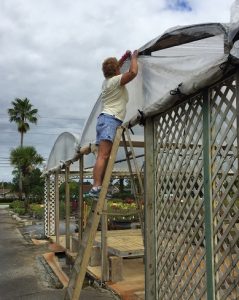As our oceans warm, hurricanes are becoming more intense and slower-moving, resulting in greater potential damage from heavy winds and flooding. The US Department of Agriculture (USDA) Southeast Climate Hub developed a series of guides specifically aimed at helping Florida producers prepare for and recover from hurricanes. This article summarizes critical preparations recommended in the short-term (within a week of storm arrival) for commercial nurseries, based on the USDA Southeast Climate Hub publication by Dr. Tom Yeager, Commercial Nursery Guide Florida.pdf (usda.gov). The Commercial Nursery Guide also includes recommended actions before hurricane season, in recovering after a storm, and in building resilience against future storms.
A few days before hurricane arrival:
- Make sure your family and your employees’ families are prepared.
- Talk with your employees about their role in storm preparation and recovery, keep them posted on the storm, and find out whether they plan to stay or evacuate. Have a plan for employees to check in after the storm, so you can make sure they are safe, and they know when it is safe to return to work.
- Gather fuel, food, water, cash, first aid, and other supplies. A two-week fuel supply is recommended.
- Store key business documents in a fire-safe and waterproof container, ideally with duplicate copies stored off-site.
- Take photos and video to document the condition of the facilities and crops before the storm. Consider checking with your insurance agent to ensure you know the information you will need in case of a claim.
- Check with your insurer to see if your policy includes coverage for loss-avoidance measures, such as sandbags and water pumps. Ask them what documentation is needed for reimbursement.
- Inspect equipment you may need during and after the storm, including backup generators, to ensure they are fueled and functioning. Sharpen chainsaw blades.
- Store equipment, pesticides, and fertilizers securely. Also, make sure chemicals are raised above any potential flooding.
- Disconnect electric and gas to areas/equipment that could be flooded.
- Inspect and repair/remove any loose components on buildings.
- Secure external objects, so they do not blow away.
- Prepare to close plastic-covered greenhouses that you think will hold up in the wind. Maintain roof inflation.
- Inspect ditches and culverts. Remove any debris that may block drainage and lower water levels as much as you can.
- Irrigate container plants and empty water from reservoirs.
- Take plants down from benches.
- Weight down the ground cloth.
The day before hurricane arrival:
- Keep yourself and your employees safe by following any mandatory evacuation orders. If you or your employees are going to evacuate, make sure to leave at least one day before the storm arrives.
- Even if they are not evacuating, do not require your employees to work at the nursery the day before the storm. If any employees are staying onsite, make sure they have a safe place to shelter with enough water, food, medical supplies, means of communication, and battery or generator power. Be sure they know to monitor water levels, so they can leave the nursery before roads flood.
- Remove greenhouse plastic and shade cloth if you do not think they will withstand the expected winds.

If the greenhouse and shadehouse coverings won’t likely withstand expected hurricane-force winds, remove covers in advance of the storm. - Dismantle irrigation risers if needed.
- Secure windows, doors, and greenhouse vents.
- Shut off gas, water, and electricity.
- Place computers and other electronics in a safe and dry location, unplugged.
- Secure items, including trailers and mixing equipment. Trailers can be placed side by side to block the wind; tractors can be placed in fields.
- Put portable generators in place.
- Lay down potted plants that are large, likely to break, and/or highly valuable; containers should be positioned into the wind.
- Highly valuable plants can also be placed in a protected space, like an enclosed trailer.
For more assistance before or after a storm, reach out to your local UF/IFAS Extension office.
 0
0
